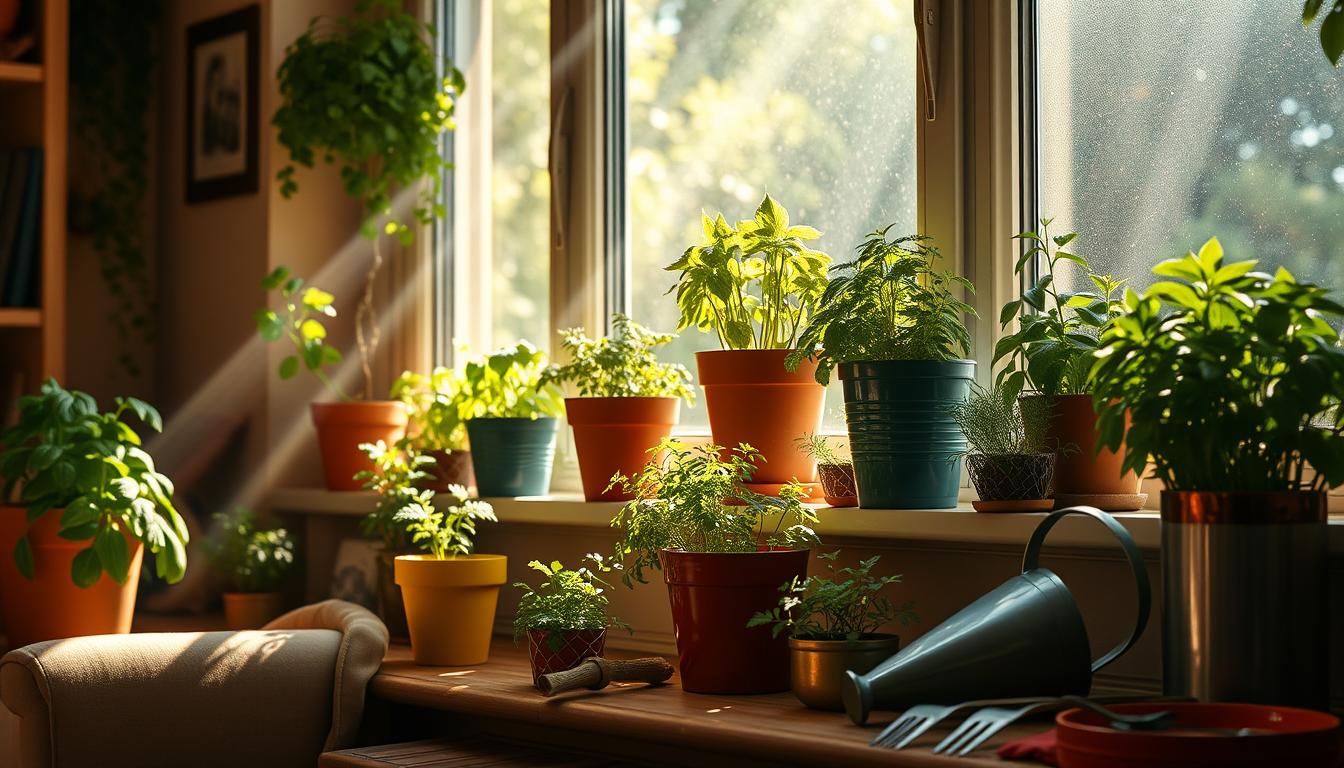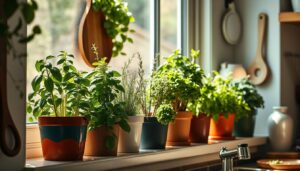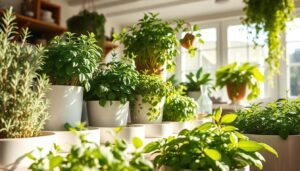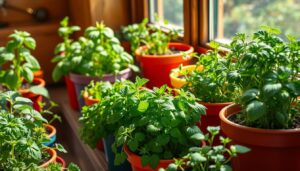Did you know indoor herbs can produce up to 30% more flavor than those grown outside? This fact shows how important sunlight is for your indoor herb garden. By learning how to place your herbs in the sun, you can make them grow better and taste fresher.
Key Takeaways
- Understand the light requirements of different herb varieties to ensure proper growth and flavor development.
- Evaluate the natural light sources in your home and use light meters to determine the optimal placement for your indoor herb garden.
- Strategically position your herb pots to maximize sunlight exposure and consider rotating them for even light distribution.
- Supplement natural light with the right grow lights to provide the necessary light intensity and duration for your indoor herbs.
- Maintain the ideal temperature and humidity levels to support the health and productivity of your indoor herb garden.
The Importance of Light for Indoor Herbs
Light is key for growing herbs indoors. It’s the main source of energy for photosynthesis. This process turns carbon dioxide and water into the nutrients herbs need to grow well. Different herbs need different amounts of light, so knowing this is important for a healthy indoor herb garden.
Light as the Primary Source of Energy for Photosynthesis
Photosynthesis is vital for plants. It uses light to turn carbon dioxide and water into glucose. This glucose is the fuel that helps herbs grow and develop. Without enough light, indoor herbs can’t make the nutrients they need to survive.
Understanding the Light Requirements of Different Herb Varieties
Herbs have different light needs. Some, like basil and rosemary, love bright sunlight. Others, like chives and parsley, can do well in less light. It’s important to know what your herbs need to help them grow well indoors.
| Herb Variety | Light Requirements |
|---|---|
| Basil | Bright, direct sunlight |
| Rosemary | Bright, direct sunlight |
| Chives | Partial shade or indirect sunlight |
| Parsley | Partial shade or indirect sunlight |
Knowing what light your indoor herbs need helps you give them the right amount of light. This lets them thrive and gives you a bountiful harvest of fresh herbs.
Assessing Indoor Light Conditions
Before picking and placing your indoor herbs, check the light in your home. Finding the best sunlight spots is key for their growth and health.
Evaluating Natural Light Sources in Your Home
Walk through your home to see where the light comes in. Look for windows on the south side, skylights, or mirrors that reflect light. Check how strong and long the sunlight lasts in each spot. Different herbs need different amounts of light.
Using Light Meters to Measure Light Intensity
Use a light meter to check the light levels in your home. These tools give exact readings of the light in different spots. This helps you find the best place for your herbs.
| Light Measurement | Ideal for Indoor Herbs |
|---|---|
| 500-1000 lux | Low-light herbs (e.g., mint, parsley) |
| 1000-2000 lux | Medium-light herbs (e.g., basil, cilantro) |
| 2000-4000 lux | High-light herbs (e.g., rosemary, thyme) |
By checking indoor light and using light meters, you can find the best spots for your herbs. This ensures your indoor herb garden does well.
Positioning Indoor Herbs for Optimal Sunlight Exposure
After finding the best spots in your home for natural light, place your indoor herbs to get the most sunlight. This careful arrangement helps your herbs grow well and gives you lots of fresh herbs.
To make the most of the herb placement for sunlight, follow these tips:
- Put your herbs near sunny windows or other bright spots. Keeping them close to these areas lets them get lots of sunlight.
- Use mirrors or light-colored walls to reflect more light onto your indoor herb garden. This trick is great for places with not much natural light.
- Turn your herb pots or planters now and then. This makes sure all plants get enough light and none are in the shade.
| Herb Variety | Minimum Light Requirement | Ideal Placement |
|---|---|---|
| Basil | 6-8 hours of direct sunlight | South-facing window |
| Thyme | 4-6 hours of direct sunlight | East or west-facing window |
| Mint | 4-6 hours of partial shade | Partially shaded area |
By thinking about where to put your indoor herbs, you can make sure they do well and give you plenty of fresh herbs at home.
Indoor herb garden sunlight tips
To grow a thriving indoor herb garden, you need more than just the right plants. You must also make sure they get enough sunlight. Sunlight is key for photosynthesis, the process by which plants make their food. By placing your herbs near sunny windows and rotating your pots, you can give them the sunlight they need to grow well.
Maximizing Sunlight with Strategic Window Placement
Getting enough sunlight is key for indoor herbs. When setting up your garden, think about where to put your pots. Put them near windows that get a lot of direct sunlight all day. Putting your herbs near south or west-facing windows is a good idea.
Rotating Herb Pots for Even Light Distribution
Rotating your herb pots is also important. It helps make sure all parts of the plant get sunlight. Turn your pots a quarter-turn every few days. This way, every side of the plant gets the same amount of light, helping it grow evenly.
Using these indoor herb garden sunlight tips, you can create the best conditions for your herbs. This lets them grow fully and gives you lots of fresh, tasty herbs for cooking.
Supplementing with Artificial Lighting
Natural sunlight is best for indoor herbs, but sometimes we need artificial lighting. Gardeners have many grow lights to choose from. These lights help plants grow well when there’s not enough natural light.
Types of Grow Lights for Indoor Herb Gardens
Here are the main types of grow lights for indoor herb gardens:
- Fluorescent lights: These are energy-saving and come in different sizes and colors. They’re great for growing herbs indoors.
- LED (light-emitting diode) lights: LEDs are energy-efficient and last a long time. They give off light types that plants need.
- HID (high-intensity discharge) lights: HID lamps, like metal halide and high-pressure sodium, give a lot of light. They’re good for big herb gardens indoors.
Setting Up an Effective Grow Light System
Here’s how to set up a good grow light system for your herbs:
- Find out how much light your herbs need and for how long.
- Put the grow lights at the right height above your herbs for even light.
- Use lights that you can move or adjust as your herbs grow.
- Use a timer or automated system to make sure your herbs get enough light each day.
- Watch how your plants are doing and change the light setup if needed to keep them healthy.
With the right artificial lighting, you can make a great indoor herb garden even in low-light places.
Managing Temperature and Humidity
Keeping the right temperature and humidity is key for your indoor herbs to stay healthy and grow well. Most herbs like a warm spot, between 60-70°F, with some moisture in the air. It can be hard to keep these conditions perfect indoors, so watch and adjust as needed to help your herbs grow the best they can.
Here are some tips for managing temperature and humidity:
- Use a thermometer and hygrometer to check the temperature and humidity often in your herb area.
- If it’s too cold, think about using a space heater or putting your herbs near a sunny window to warm them up.
- For too much humidity, mist your herbs or use a small humidifier. Putting your herb pots close together can also help keep the air moist.
- Don’t put your herbs where there are strong drafts or near air vents, as big temperature changes can harm them.
- Change how often you water your herbs based on what they need to keep the right moisture.
By keeping a close eye on and adjusting the temperature and humidity for your indoor herbs, you’ll make sure they grow well. This will give you a lot of fresh herbs for your kitchen.
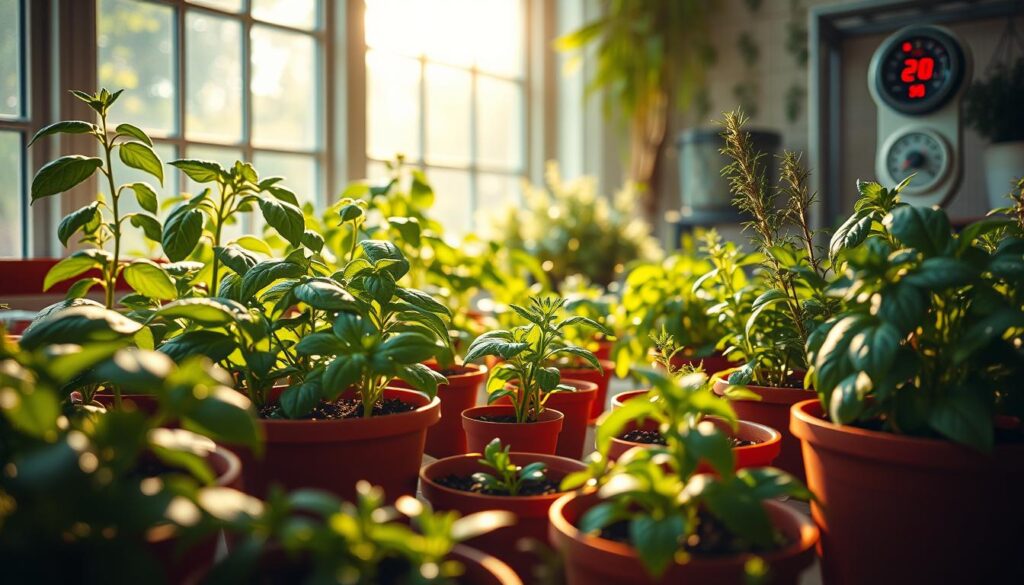
“The secret to growing thriving indoor herbs is understanding and controlling the environment. Temperature and humidity are just as important as sunlight.”
Watering and Fertilizing Indoor Herbs
Watering and fertilizing your indoor herbs right is key to their success. It’s important to keep a balance to keep your herbs healthy. Let’s look at the best watering techniques for indoor herbs and the right fertilizers and application schedule for your plants.
Proper Watering Techniques for Indoor Herbs
Don’t overwater, as it can cause root rot. Instead, water your herbs when the top inch of soil feels dry. Check your plants every few days and water as needed. Be gentle when watering, making sure the soil is moist but not too wet.
- Check the soil moisture regularly by sticking your finger into the soil up to the first knuckle.
- Water your herbs when the top inch of soil feels dry to the touch.
- Gently water the soil around the base of the plants, being careful not to get the leaves wet.
- Ensure the water drains freely from the bottom of the pots to prevent waterlogging.
Selecting the Right Fertilizers and Application Schedule
Use a balanced, water-soluble fertilizer made for herbs or vegetables. Add this fertilizer every two to four weeks during the growing season. This gives your plants the nutrients for indoor herb gardens they need. Always follow the recommended application rates to avoid harming your herbs with too much fertilizer.
- Choose a balanced, water-soluble fertilizer designed for herbs or vegetables.
- Apply the fertilizer every two to four weeks during the growing season.
- Follow the manufacturer’s instructions for the recommended application rate.
- Avoid over-fertilizing, as this can damage your plants.
“Properly watering and fertilizing your indoor herbs is crucial for their growth and overall health. With the right techniques, you can ensure your plants thrive and provide a bountiful harvest.”
By using the best watering techniques for indoor herbs and the right fertilizers and nutrients, you can have a thriving indoor herb garden. This will give you fresh, flavorful herbs for your cooking.
Pest and Disease Control
Even in indoor herb gardens, pests and diseases can be a problem. It’s important to watch your plants closely and take steps to prevent pests like aphids, spider mites, and powdery mildew.
Common Pests in Indoor Herb Gardens
Aphids are a common pest in indoor herb gardens. These small insects can quickly multiply and harm your herbs. They leave behind a sticky substance. Spider mites are also a problem, spinning webs and sucking the life from your plants.
Powdery mildew is a fungal disease that can affect indoor herbs. It covers leaves in a white powder, stopping them from making food.
Organic and Chemical Control Methods
- Use beneficial insects like ladybugs or lacewings to control aphids and other pests.
- Neem oil, from the neem tree, can fight off many pests.
- If organic methods don’t work, use low-toxicity chemicals to protect your herbs.
Check your plants often, keep their area clean, and act fast if you see pests or diseases. With careful watching and the right control methods, your indoor herb garden will flourish. You’ll get lots of tasty, healthy herbs.
| Pest/Disease | Organic Control | Chemical Control |
|---|---|---|
| Aphids | Ladybugs, Lacewings, Neem Oil | Insecticidal Soap, Horticultural Oil |
| Spider Mites | Neem Oil, Predatory Mites | Miticides |
| Powdery Mildew | Baking Soda Solution, Milk Solution | Fungicides |
“Vigilant pest and disease management is the key to a thriving indoor herb garden. A proactive approach can make all the difference in maintaining the health and productivity of your plants.”
Harvesting and Preserving Indoor Herbs
Growing indoor herbs lets you enjoy fresh flavors and aromas all year. Learning how to harvest indoor herbs and preserve indoor herbs can make your harvests last longer.
Harvesting at the right time is crucial. Cut your herbs in the morning for the best flavor. Use sharp scissors or pruners to take just the right amount, leaving enough for the plant to keep growing. Don’t take too much, as it can harm the plant.
- Harvest herbs in the morning for maximum flavor
- Use clean, sharp scissors or pruners to snip leaves or stems
- Leave enough foliage to allow the plant to continue growing
To preserve indoor herbs, you can dry, freeze, or make oils and vinegars. Drying is a simple way to keep herbs fresh. Hang them upside down in a cool spot or use a dehydrator. Freezing herbs in ice cube trays with water or oil is also a good idea, making them easy to add to dishes anytime.
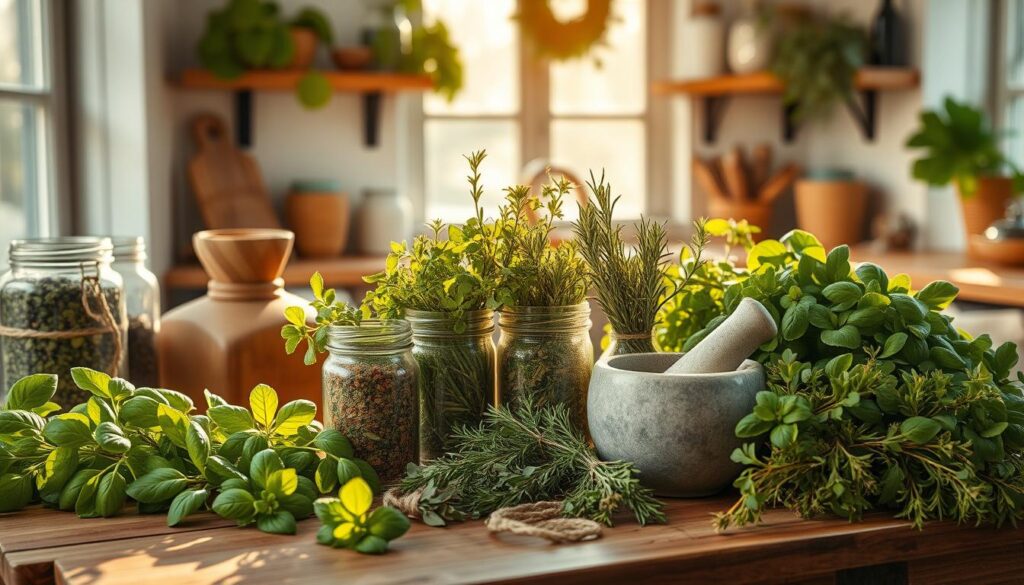
With the right methods, you can extend the life of your indoor herb harvests. Try different preservation methods to find what works best for you and your cooking.
Creative Ideas for Indoor Herb Displays
Growing an indoor herb garden is rewarding and adds beauty to your home. It’s not just about having fresh herbs. You can also find creative ways to display your indoor herbs that make your space look better. Let’s look at two great ideas for showing off your indoor herbs.
Windowsill Herb Gardens
Turning your windowsill into a windowsill herb garden is a smart choice. Put different herbs in pots on your sunny windowsill. They’ll get plenty of natural light and make your home look greener. This is great for city folks or those with little floor space. It uses the often-wasted space by your windows.
Vertical Herb Gardens and Living Walls
Think about making a vertical herb garden or a living wall for a new look. These setups stack or mount herb containers in a way that saves space. They give you lots of room for your herb garden displays and make your home look unique and beautiful.
Choosing between a windowsill or vertical garden depends on what you like. The main thing is to mix usefulness with good looks. By showing off your indoor herbs in creative ways, you can make your home feel fresh and inspiring.
Troubleshooting Common Issues
Growing herbs indoors can be rewarding but comes with challenges. With some troubleshooting, you can fix common problems. Let’s look at ways to keep your indoor herb garden healthy.
Stunted Growth
If your herbs aren’t growing well, they might not get enough sunlight, water, or nutrients. Make sure they get enough light, either from the sun or grow lights. Check how often you water and adjust if needed. Also, think about using a balanced fertilizer for nutrients.
Leaf Discoloration
Leaf discoloration, like yellowing or browning, can mean several things. It could be from too much or too little water, or not enough nutrients. Fix your watering, test the soil for nutrients, and ensure good air flow to help your leaves stay healthy.
Pest Infestations
Indoor herb gardens can get pests like aphids, spider mites, or fungus gnats. Check your plants often for pests and deal with them quickly. Using organic pest control, like beneficial insects or insecticidal soaps, can help without harming your herbs.
| Common Indoor Herb Problems | Possible Causes | Solutions |
|---|---|---|
| Stunted Growth | Insufficient light, improper watering, nutrient deficiency | Provide adequate sunlight or supplement with grow lights, adjust watering schedule, use balanced fertilizer |
| Leaf Discoloration | Overwatering, underwatering, nutrient imbalance, poor air circulation | Optimize watering, test soil, improve air flow |
| Pest Infestations | Aphids, spider mites, fungus gnats | Introduce beneficial insects, use organic pest control methods |
By taking care of these common issues with proper care and solutions, you can keep your indoor herb garden healthy. Enjoy the fresh, flavorful herbs you grow yourself.
Conclusion
Growing herbs indoors is rewarding and practical. It lets you have fresh, flavorful herbs at home. By knowing about light, temperature, and humidity, you can make a great indoor herb garden. This garden will make your cooking better and add beauty to your home.
Your indoor herb garden can be a source of pride and joy. It offers many benefits, like having herbs ready and feeling proud of your garden. Even in cities or suburbs, you can have a lush garden.
Starting to grow herbs indoors means you’re improving your cooking and living healthier. Embrace the challenges and enjoy the successes. Your indoor herb garden will make your kitchen and life better.
FAQ
What are the key factors for maximizing sunlight for an indoor herb garden?
How do I assess the natural light conditions in my home for indoor herb gardening?
What types of grow lights are best for supplementing natural light for indoor herbs?
How do I maintain the right temperature and humidity levels for indoor herbs?
What are the best watering and fertilization practices for an indoor herb garden?
How do I address common pests and diseases in an indoor herb garden?
What are some creative ways to display an indoor herb garden?
How can I troubleshoot common issues with my indoor herb garden?
Source Links
- Growing plants indoors: A beginner’s guide — HOMESTEAD BROOKLYN – https://homesteadbrooklyn.com/all/2017/1/21/growing-plants-indoors-a-beginners-guide
- Growing Herbs Indoors How To Grow Fresh Herbs Indoors – https://www.herbgardenlady.com/growing-herbs-indoors.html
- The Ultimate Guide to Growing Fresh Herbs Indoors – https://marshydroled.co.uk/2023/07/14/the-ultimate-guide-to-growing-fresh-herbs-indoors/


